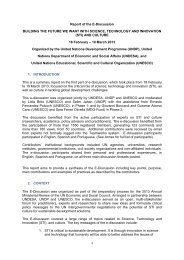THE FUTURE OF NUCLEAR ENERGY TO 2030 AND ITS ... - acuns
THE FUTURE OF NUCLEAR ENERGY TO 2030 AND ITS ... - acuns
THE FUTURE OF NUCLEAR ENERGY TO 2030 AND ITS ... - acuns
You also want an ePaper? Increase the reach of your titles
YUMPU automatically turns print PDFs into web optimized ePapers that Google loves.
The Centre for International Governance Innovation<br />
in China, notably for coal. India, now free of import constraints,<br />
may advance faster than in the past, but has never<br />
come anywhere near its previous outlandish targets. Even<br />
in the United States, seen as a bellwether of the nuclear<br />
revival following the launch of its Nuclear Power 2010<br />
program in 2002, construction has not started on a single<br />
new reactor, despite loan guarantees and other subsidies<br />
for early entrants. Industry promoters predict that only<br />
four to eight new reactors will come online in the US by<br />
2015 and then only if even bigger government loan guarantees<br />
materialize. Canada’s plans for new build have so<br />
far come to naught, with cancellations by Ontario and<br />
hesitation in Alberta and Saskatchewan. France, already<br />
so well supplied with nuclear electricity that it exports it,<br />
is building just one new reactor. However, French companies<br />
Areva and Electricité de France are gearing up to<br />
export and operate reactors abroad. Russia has elaborate<br />
domestic and export schemes but faces significant barriers<br />
in realizing all of these. South Korea envisages relatively<br />
steady expansion of an already sizeable fleet of reactors<br />
and has export intentions that have already been realized<br />
with a sale to the United Arab Emirates (UAE).<br />
Many existing nuclear energy states have no plans for expansion.<br />
Currently, of the European states that decided to<br />
phase out nuclear power after Chernobyl, only Italy has<br />
completely reversed its position, while Sweden has partly<br />
done so. With the electorate deeply divided, the current<br />
government in Germany plans only to extend the existing<br />
phase-out. South Africa has cancelled its expansion plans<br />
due to its financial situation. Australia, despite huge uranium<br />
deposits, continues to reject nuclear electricity.<br />
A small number of new entrants may succeed in acquiring<br />
their first nuclear reactors by <strong>2030</strong>, among them two<br />
European countries — Poland and Turkey. A handful<br />
of developing states, those with oil wealth and/or command<br />
economies, or special support from other countries,<br />
may be able to embark on a modest program of one<br />
or two reactors. The most likely candidates appear to be<br />
Algeria, Egypt, Indonesia, Jordan, Kazakhstan, the UAE<br />
and Vietnam, although some of these have envisaged acquiring<br />
nuclear reactors for decades and all face significant<br />
challenges in doing so now.<br />
It is thus likely that expansion in nuclear energy to<br />
<strong>2030</strong> will be confined largely to the existing nuclear<br />
energy producers, plus a handful of newcomers. For<br />
the vast majority of states, nuclear energy will remain<br />
as elusive as ever.<br />
Technology Trends to <strong>2030</strong><br />
Most “new build” to <strong>2030</strong> is likely to be Generation III+<br />
light-water reactors, of 1,000 megawatt (MW) capacity<br />
and above, in order to achieve economies of scale. Three<br />
individual brands (Areva, Westinghouse/Toshiba and<br />
General Electric/Hitachi) are poised to dominate the<br />
global export market. Construction consortia, sometimes<br />
assembled by utilities like Electricité de France or new<br />
entrants like South Korea, are required, as no single company<br />
can currently build a nuclear power plant singlehandedly.<br />
It is not clear whether Canada, India or Russia<br />
will succeed in exporting new reactor types.<br />
New generation reactor technology promises to be more<br />
efficient, safer and more proliferation-resistant, but this<br />
remains to be demonstrated. Nuclear power will continue<br />
to prove most useful for baseload electricity in countries<br />
with extensive, established grids. Lifetime extensions and<br />
renovation will continue to prolong the life of existing reactors<br />
to <strong>2030</strong> and in some cases beyond: they are proving<br />
profitable since construction costs have long been written<br />
off and running costs, including for fuel, are low.<br />
Large nuclear plants will continue to be infeasible for<br />
most developing states and other states with small or<br />
fragile electricity systems. Small reactors are still in the<br />
research and development stage and are unlikely to be<br />
widespread by <strong>2030</strong>. A couple of pilot Generation IV re-<br />
12 cigionline.org










